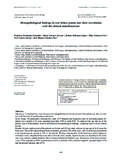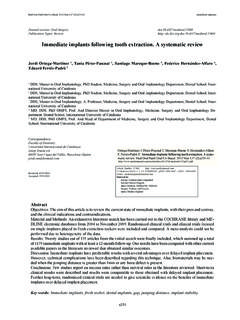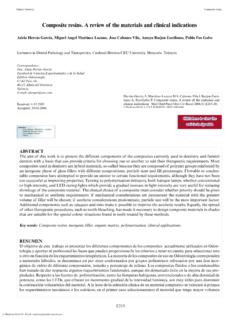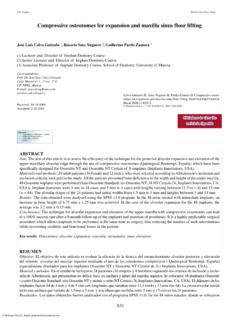Transcription of Dental considerations in patients with liver disease
1 E127J Clin Exp Dent. 2011;3(2):e127-34. Dental treatment in patients with liver section: oral Medicine and Pathology Types: ReviewDental considerations in patients with liver disease Marta Cruz-Pamplona 1, Mar a Margaix-Mu oz 1, Maria Gracia Sarri n-P rez 11 Degree in Dentistry. Master in oral Medicine and Surgery. Faculty of Medicine and Dentistry. University of Valencia. :Av/ Gaspar Aguilar 81-1346017 Valencia, SpainPhone: 630166697E-mail: 23/06/2010 Accepted: 16/01/2011 Abstract Introduction: liver diseases are very common, and the main underlying causes are viral infections, alcohol abuse and lipid and carbohydrate metabolic disorders.
2 The liver has a broad range of functions in maintaining homeos-tasis and health, and moreover metabolizes many drug substances. Objective: An update is provided on the oral manifestations seen in patients with viral hepatitis, alcoholic and non-alcoholic liver disease , cirrhosis and hepa-tocellular carcinoma, and on the Dental management of such patients . Material and methods: A Medline-PubMed search was conducted of the literature over the last 15 years using the keywords: hepatitis , alcoholic hepatitis , fatty liver , cirrhosis and hepatocellular carcinoma . A total of 28 articles were reviewed, comprising 20 lite-rature reviews, a clinical guide, three clinical trials and four case series.
3 Results: oral clinical manifestations can be observed reflecting liver dysfunction, such as bleeding disorders, jaundice, foetor hepaticus, cheilitis, smooth tongue, xerostomia, bruxism and crusted perioral rash. In the case of infection caused by hepatitis C virus (HCV), the most frequent extrahepatic manifestations mostly affect the oral region in the form of lichen planus, xerostomia, Sj gren s syndrome and sialadenitis. The main complications of the patient with liver disease are risk of contagion (for healthcare personnel and other patients ), the risk of bleeding and the risk of toxicity due to alteration of the metabolism of certain words: Hepatitis, alcoholic hepatitis, fatty liver , cirrosis, hepatocellular M, Margaix-Mu oz M, Gracia Sarri n-P rez MG.
4 Dental considerations in patients with liver disease . J Clin Exp Dent. 2011;3(2) Number: 50340 Medicina oral S. L. B 96689336 - eISSN: 1989-5488eMail: Clin Exp Dent. 2011;3(2):e127-34. Dental treatment in patients with liver liver diseases are very common and can be classified as acute (characterized by rapid resolution and complete restitution of organ structure and function once the un-derlying cause has been eliminated) or chronic (charac-terized by persistent damage, with progressively impai-red organ function secondary to the increase in liver cell damage).
5 Based on the extent and origin of the damage, chronic liver disease ranges from steatosis or fatty liver to hepatocellular carcinoma, and includes hepatitis, fi-brosis and cirrhosis. liver diseases can also be classified as infectious (hepatitis A, B, C, D and E viruses, infec-tious mononucleosis, or secondary syphilis and tubercu-losis) or non-infectious (substance abuse such as alcohol and drugs, , paracetamol, halothane, ketoconazole, methyldopa and methotrexate) (1).The liver has a broad range of functions in maintaining homeostasis and health: it synthesizes most essential serum proteins (albumin, transporter proteins, blood coagulation factors V, VII, IX and X, prothrombin and fibrinogen (1), as well as many hormone and growth factors), produces bile and its transporters (bile acids, cholesterol, lecithin, phospholipids), intervenes in the regulation of nutrients (glucose, glycogen, lipids, cho-lesterol, amino acids), and metabolizes and conjugates lipophilic compounds (bilirubin, cations, drugs) to faci-litate their excretion in bile or urine.
6 liver dysfunction alters the metabolism of carbohydrates, lipids, proteins, drugs, bilirubin and hormones (2). Accordingly, liver di-sease is characterized by a series of aspects that must be taken into account in the context of medical and Dental care (3).Since many drug substances are metabolized in the liver , it is essential for the clinician to compile a complete me-dical history, evaluating all body systems and the medi-cation used by the patient. The patient drug metabolizing capacity can be evaluated based on the analysis of enzy-mes such as alanine aminotransferase (ALT) or aspartate aminotransferase (AST), and other liver function tests (2, 4).
7 In situations of advanced liver disease , the vitamin K le-vels can be significantly lowered, thus giving rise to a re-duction in the production of blood coagulation factors. In addition, portal hypertension can scavenge platelets for-med in the spleen, thus giving rise to thrombocytopenia. This in turn can lead to an excessive bleeding tendency, which is one of the main adverse effects seen during the treatment of patients with impaired liver function (4).Dentists are particularly at risk of hepatitis B and C con-tagion, due to the transmission routes of these viruses, since these professionals are exposed to the blood and oral secretions of potentially infected individuals (5) particularly in the case of accidents with sharp or cutting HEPATITISH epatitis of viral origin comprises a heterogeneous group of diseases caused by at least 6 different types of viruses: A, B, C, D, E and G (2).
8 Five million new cases of viral hepatitis are documented each year throughout the world, and a study published by Chandler-Guti rrez et al. (6) estimates the prevalence in Spain to be Hepatitis AHepatitis A is caused by the hepatitis A virus (HAV), an RNA picornavirus (3) endemic in many developing countries. Its estimated prevalence is (6). This vi-rus is transmitted via the enteral ( oral -fecal) route (5), as a result of the ingestion of contaminated water or food (mollusks), though intrafamilial contagion has also been described, as well as contagion in closed institutions and secondary to sexual disease is typically mild and self-limiting, and is cha-racterized by the sudden onset of nonspecific symptoms.
9 There is no carrier state. In children or young indivi-duals the disease tends to be asymptomatic, while adults typically present fever, fatigue, abdominal discomfort, diarrhea, nausea and/or jaundice. The patient is able to transmit the infection during the incubation period (2-6 weeks) and until the appearance of diagnosis is based on the signs and symptoms and on serological testing for anti-HAV IgM and IgG anti-bodies (3). Host response in the form of anti-HAV anti-bodies affords lifelong immunity, protecting the patient against future HAV infection.
10 The risk of nosocomial contagion among healthcare per-sonnel is quite low (3). Vaccines are available that offer immunity against HAV (Havrix , Vaqta ) for people at risk ( , subjects traveling to endemic areas, drug abusers, patients with chronic liver disease and subjects with occupational risk factors) (2, 3).- Hepatitis BThe hepatitis B virus (HBV) is an encapsulated DNA virus that replicates within the hepatocyte (3). Hepatitis B is a worldwide health problem, with an estimated 400 million carriers of the virus (5). It has been calculated that of all patients reporting to the Dental clinic are HBV carriers (6).














